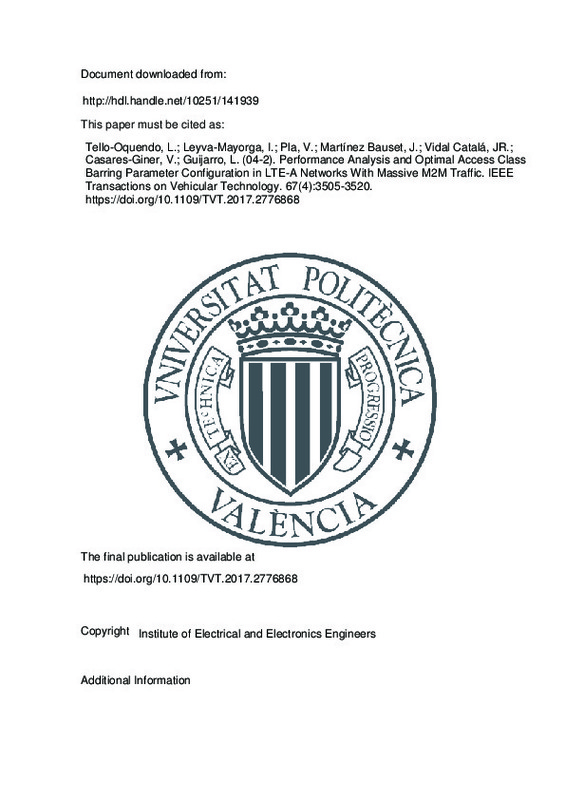JavaScript is disabled for your browser. Some features of this site may not work without it.
Buscar en RiuNet
Listar
Mi cuenta
Estadísticas
Ayuda RiuNet
Admin. UPV
Performance Analysis and Optimal Access Class Barring Parameter Configuration in LTE-A Networks With Massive M2M Traffic
Mostrar el registro sencillo del ítem
Ficheros en el ítem
| dc.contributor.author | Tello-Oquendo, Luis
|
es_ES |
| dc.contributor.author | Leyva-Mayorga, Israel
|
es_ES |
| dc.contributor.author | Pla, Vicent
|
es_ES |
| dc.contributor.author | Martínez Bauset, Jorge
|
es_ES |
| dc.contributor.author | Vidal Catalá, José Ramón
|
es_ES |
| dc.contributor.author | Casares-Giner, Vicente
|
es_ES |
| dc.contributor.author | Guijarro, Luis
|
es_ES |
| dc.date.accessioned | 2020-04-29T07:04:06Z | |
| dc.date.available | 2020-04-29T07:04:06Z | |
| dc.date.issued | 2018-04 | es_ES |
| dc.identifier.issn | 0018-9545 | es_ES |
| dc.identifier.uri | http://hdl.handle.net/10251/141939 | |
| dc.description.abstract | [EN] Over the coming years, it is expected that the number of machine-to-machine (M2M) devices that communicate through long term evolution advanced (LTE-A) networks will rise significantly for providing ubiquitous information and services. However, LTE-A was devised to handle human-to-human traffic, and its current design is not capable of handling massive M2M communications. Access class barring (ACB) is a congestion control scheme included in the LTE-A standard that aims to spread the accesses of user equipments (UEs) through time so that the signaling capabilities of the evolved Node B are not exceeded. Notwithstanding its relevance, the potential benefits of the implementation of ACB are rarely analyzed accurately. In this paper, we conduct a thorough performance analysis of the LTE-A random access channel and ACB as defined in the 3GPP specifications. Specifically, we seek to enhance the performance of LTE-A in massive M2M scenarios by modifying certain configuration parameters and by the implementation of ACB. We observed that ACB is appropriate for handling sporadic periods of congestion. Concretely, our results reflect that the access success probability of M2M UEs in the most extreme test scenario suggested by the 3GPP improves from approximately 30%, without any congestion control scheme, to 100% by implementing ACB and setting its configuration parameters properly. | es_ES |
| dc.description.sponsorship | This work was supported in part by the Ministry of Economy and Competitiveness of Spain under Grants TIN2013-47272-C2-1-R and TEC2015-71932-REDT. The work of L. Tello-Oquendo was supported in part by Programa de Ayudas de Investigacion y Desarrollo (PAID), Universitat Politecnica de Valencia. The work of I. Leyva-Mayorga was supported in part by Grant 383936 CONACYT-Gobierno del Estado de Mexico 2014. | es_ES |
| dc.language | Inglés | es_ES |
| dc.publisher | Institute of Electrical and Electronics Engineers | es_ES |
| dc.relation.ispartof | IEEE Transactions on Vehicular Technology | es_ES |
| dc.rights | Reserva de todos los derechos | es_ES |
| dc.subject | Access class barring (ACB) | es_ES |
| dc.subject | Cellular-systems | es_ES |
| dc.subject | Machine-to-machine communications | es_ES |
| dc.subject | Performance analysis | es_ES |
| dc.subject.classification | INGENIERIA TELEMATICA | es_ES |
| dc.title | Performance Analysis and Optimal Access Class Barring Parameter Configuration in LTE-A Networks With Massive M2M Traffic | es_ES |
| dc.type | Artículo | es_ES |
| dc.identifier.doi | 10.1109/TVT.2017.2776868 | es_ES |
| dc.relation.projectID | info:eu-repo/grantAgreement/CONACyT//383936/ | es_ES |
| dc.relation.projectID | info:eu-repo/grantAgreement/MINECO//TEC2015-71932-REDT/ES/ELASTIC NETWORKS: NUEVOS PARADIGMAS DE REDES ELASTICAS PARA UN MUNDO RADICALMENTE BASADO EN CLOUD Y FOG COMPUTING/ | es_ES |
| dc.relation.projectID | info:eu-repo/grantAgreement/MINECO//TIN2013-47272-C2-1-R/ES/PLATAFORMA DE SERVICIOS PARA CIUDADES INTELIGENTES CON REDES M2M DENSAS/ | es_ES |
| dc.rights.accessRights | Abierto | es_ES |
| dc.contributor.affiliation | Universitat Politècnica de València. Departamento de Comunicaciones - Departament de Comunicacions | es_ES |
| dc.description.bibliographicCitation | Tello-Oquendo, L.; Leyva-Mayorga, I.; Pla, V.; Martínez Bauset, J.; Vidal Catalá, JR.; Casares-Giner, V.; Guijarro, L. (2018). Performance Analysis and Optimal Access Class Barring Parameter Configuration in LTE-A Networks With Massive M2M Traffic. IEEE Transactions on Vehicular Technology. 67(4):3505-3520. https://doi.org/10.1109/TVT.2017.2776868 | es_ES |
| dc.description.accrualMethod | S | es_ES |
| dc.relation.publisherversion | https://doi.org/10.1109/TVT.2017.2776868 | es_ES |
| dc.description.upvformatpinicio | 3505 | es_ES |
| dc.description.upvformatpfin | 3520 | es_ES |
| dc.type.version | info:eu-repo/semantics/publishedVersion | es_ES |
| dc.description.volume | 67 | es_ES |
| dc.description.issue | 4 | es_ES |
| dc.relation.pasarela | S\358470 | es_ES |
| dc.contributor.funder | Universitat Politècnica de València | es_ES |
| dc.contributor.funder | Ministerio de Economía y Competitividad | es_ES |
| dc.contributor.funder | Consejo Nacional de Ciencia y Tecnología, México | es_ES |
| dc.contributor.funder | Ministerio de Economía, Industria y Competitividad | es_ES |







![[Cerrado]](/themes/UPV/images/candado.png)

